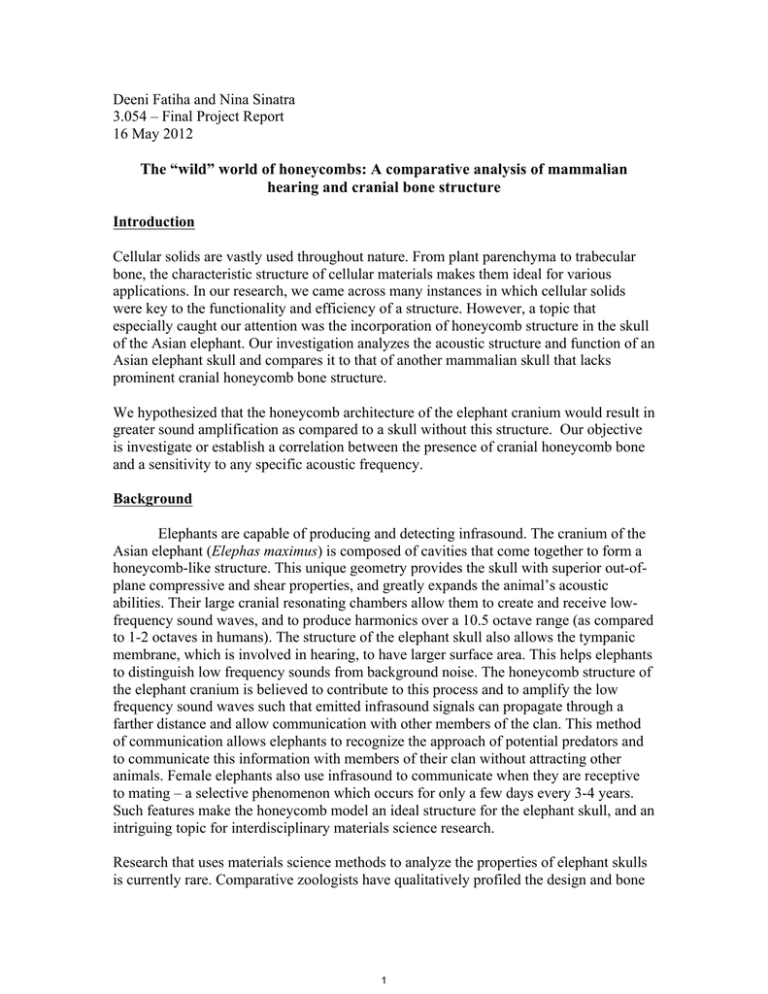Deeni Fatiha and Nina Sinatra 3.054 – Final Project Report
advertisement

Deeni Fatiha and Nina Sinatra 3.054 – Final Project Report 16 May 2012 The “wild” world of honeycombs: A comparative analysis of mammalian hearing and cranial bone structure Introduction Cellular solids are vastly used throughout nature. From plant parenchyma to trabecular bone, the characteristic structure of cellular materials makes them ideal for various applications. In our research, we came across many instances in which cellular solids were key to the functionality and efficiency of a structure. However, a topic that especially caught our attention was the incorporation of honeycomb structure in the skull of the Asian elephant. Our investigation analyzes the acoustic structure and function of an Asian elephant skull and compares it to that of another mammalian skull that lacks prominent cranial honeycomb bone structure. We hypothesized that the honeycomb architecture of the elephant cranium would result in greater sound amplification as compared to a skull without this structure. Our objective is investigate or establish a correlation between the presence of cranial honeycomb bone and a sensitivity to any specific acoustic frequency. Background Elephants are capable of producing and detecting infrasound. The cranium of the Asian elephant (Elephas maximus) is composed of cavities that come together to form a honeycomb-like structure. This unique geometry provides the skull with superior out-ofplane compressive and shear properties, and greatly expands the animal’s acoustic abilities. Their large cranial resonating chambers allow them to create and receive lowfrequency sound waves, and to produce harmonics over a 10.5 octave range (as compared to 1-2 octaves in humans). The structure of the elephant skull also allows the tympanic membrane, which is involved in hearing, to have larger surface area. This helps elephants to distinguish low frequency sounds from background noise. The honeycomb structure of the elephant cranium is believed to contribute to this process and to amplify the low frequency sound waves such that emitted infrasound signals can propagate through a farther distance and allow communication with other members of the clan. This method of communication allows elephants to recognize the approach of potential predators and to communicate this information with members of their clan without attracting other animals. Female elephants also use infrasound to communicate when they are receptive to mating – a selective phenomenon which occurs for only a few days every 3-4 years. Such features make the honeycomb model an ideal structure for the elephant skull, and an intriguing topic for interdisciplinary materials science research. Research that uses materials science methods to analyze the properties of elephant skulls is currently rare. Comparative zoologists have qualitatively profiled the design and bone 1 configuration of the animals’ cranium, and there are several existing resources that tentatively describe the acoustic properties of the Elephas maximus skull. However, no papers performing a comparative analysis between acoustic abilities of mammalian or fish skulls on the basis of honeycomb bone structure have been published (to our knowledge). We feel that this gap represents a significant intersection between the fields of structural materials science and zoology that has not yet been explored. This paper will solve this problem by presenting a novel approach to analyzing the acoustic abilities of animals using a 3D printed model of their respective skulls. Materials and Methods Visit to Harvard Museum of Comparative Zoology Prior to experimentation, our project began with a visit to the Harvard Museum of Comparative Zoology to investigate Elephas maximus skulls in the museum’s collection. Professor Gibson and Nina examined and photographed several adult Asian elephant skulls, taking note of the unique honeycomb bone structure within. The animal’s cranium showed especially prominent interior cavities in the rear and forehead, the latter of which is especially consistent with infrasound reception. Figure 1 shows a full adult Elephas maximus skull from the museum collection, and a closer view of the honeycombs. Figure 1: An adult Elephas maximus skull from the Harvard MCZ’s collection, and a close-up of honeycomb bone structure behind the eye socket. 2 Construction of 3D Skull Models In order to analyze the acoustic properties of the Elephas maximus skull, we retrieved a CT scan of an Asian elephant cranium through Digimorph. Digimorph is an NSF-funded digital library based at the University of Texas, Austin, and features models of mammal, fish, reptile, and dinosaur skulls courtesy of the UT Texas High-Resolution X-ray CT Facility. This specimen was scanned at the Heart Hospital of Austin using an Imatron C150 XP/LP “ultra-fast” CT. In order to compare the elephant’s honeycomb bone structure with a hollower cranium, a model of a bottlenose dolphin (Tursiops truncatus) skull was also downloaded from Digimorph. Both models were recovered from juvenile male animals, and were scaled by 0.5 in order to fit the dimensions of our laboratory equipment. Figure 2 depicts slices of the elephant and dolphin skull scans, clearly showing the honeycomb structure present in the Elephas maximus skull and the hollow (minimal honeycomb) configuration of the Tursiops truncates cranium. Photo removed due to copyright restrictions. See Balanoff, Amy. 2003. "Elephas Maximus." (On-line) Digital Morphology. Accessed November 21, 2014 at http://digimorph.org/specimens/Elephas_maximus/skull/. Photo removed due to copyright restrictions. Racicot, Rachel and Matthew Colbert. 2002. "Tursiops Truncatus." (On-line) Digital Morphology. Accessed November 21, 2014 at http://digimorph.org/specimens/Tursiops_truncatus/. Figure 2: Slices of CT scans of the Asian elephant and bottlenose dolphin skull scans, demonstrating a stark contrast between honeycomb and hollow bone structure (respectively). 3 The skulls were fabricated using a Z Corporation Spectrum 3D printer; the apparatus renders geometrically complex objects using a blend of water, HP ink, and polymer solution to solidify a polymer-blended gypsum powder. After printing, the models were cleaned using a small paintbrush and a pen-sized air jet, and subsequently infused with wax to reduce brittleness; Figure 3 presents a glimpse of the manufacturing process for both skulls. While the Tursiops truncates skull was printed in full (minus the jaw and teeth), the Elephas maximus skull was printed in three layered pieces to reduce the risk of collapse from the weight of excess powder inside. Figure 3: An Elephas maximus cross-section being rendered in the 3D printer, and the Tursiops truncatus skull being waxed during post-processing. Acoustic Equipment and Testing Two skull models were subjected to acoustic testing in order to determine whether a larger cranial honeycomb bone structure allows an animal to amplify sound waves better 4 than a more common sandwich bone structure. The bottlenose dolphin skull (selected because it contains no honeycomb structure) was compared to a three-layered Asian elephant skull model. The delicate nature of the powder models, even in post-processing, discouraged us from printing and testing an elephant skull printed as a single piece; instead, thick cross-sections were securely bound together to simulate a full skull. The elephant skull was bound using a rigging system devised of standard rubber bands; this material ensured that the model would be permitted to shift and flex while retaining a secure fit. A powered hand drill was used to attach a PCB Piezoelectronics ICP (integrated circuit piezoelectric) accelerometer to the interior of each subject, located on the upper left “forehead.” Both the accelerometer and a large audiovisual amplifier were wired to a SR760 single-channel spectrum analyzer. This machine was connected to a laptop running LabView 2010 software, as shown in Figure 4. A custom program to acquire and save acoustic data from the spectrum analyzer was designed using LabView’s software architecture. This experimental setup permitted us to adjust the properties of the sound input (e.g. volume, auto-scale, frequency averaging) before the data was saved. Both skulls were suspended in turn from a fixed point using a second rubber band rigging; the net-like structure supported each model in an upright position precisely 23 inches from the laboratory countertop. The amplifier was placed on top of the counter, 43 inches from the skull. 5 Figure 4: The experimental setup, with a close-up of the accelerometer’s position inside the two-part elephant skull. White noise was projected toward the skulls by the amplifier, set at the unit’s maximum volume level. The received frequencies were auto-ranged and –scaled by the spectrum analyzer, and the LabView software recorded an average of the resulting waves. Results and Discussion Figure 5 displays the data recovered from the application of white noise to the dolphin and elephant skulls; the frequency of sound waves is examined against the decibel level recorded by the accelerometer to provide an estimation of the tones perceived by the animals. Decibels are measured on a logarithmic scale, with negative numbers indicating sound waves with low amplitude. This measurement is a common feature in analyses of hearing ability or hearing loss. 6 Figure 5: This chart presents the frequencies recorded by the accelerometer in each skull model. This data suggests that the elephant skull can receive and perceive low frequency sounds more successfully than the dolphin model. As frequency increases past 20 kHz, the elephant skull’s sensitivity to sound (measured in decibels) decreases steadily, while the dolphin skull shows a near-proportional increase. This result is consistent with physiological hearing capabilities of both animals. Bottlenose dolphins have a superior hearing range, particularly in the ultrasound region, and can perceive sound from 0.2-150 kHz. Asian elephants, in comparison, are more adept in recognizing infrasound, and display acoustic sensitivity between 0.016-12 kHz. The prevalence of thick honeycomb bone structure in the Elephas maximus’ cranium and the animal’s sensitivity to infrasound waves suggests that the species uses bone conduction to hear low-frequency sound. Our results indicate that the Asian elephant can detect these sound waves better than the bottlenose dolphin, whose skull displays no honeycomb bone configuration. It is important to understand that cartilage and soft tissues also aid that acoustic conduction in animal skulls; however, the focus of this project is upon the auditory structure and function of cranial bone architecture, and the abilities that this feature promotes. Conclusion and Recommendations Within the scope of this work, it is ultimately unclear whether acoustic sensitivity can be completely and reliably correlated to the amount of honeycomb bone structure present in an animal’s cranium. Our results indicated a positive proportionality, but to unequivocally prove this point, it would also be necessary to test the relationship between the size of an animal’s skull and its capacity to receive sound. Larger skulls in animals represent sizable resonating chambers that can optimally register low frequency sound 7 waves. The presence of honeycomb bone chambers within a skull has been shown throughout topical literature to positively contribute to these abilities. In order to conclusively understand the relationship between the size of a skull, the degree of honeycomb structure present, and the frequencies of sound that an animal hears, it would be necessary to fabricate additional skulls representing a variety of mammalian species. The experimentation methodology would be more accurate if entire skulls could be printed out using a larger Z-Corporation 3D printer. We were constrained during this investigation by the limited amount of CT scans available on Digimorph and the time and printer volume required to print; additional resources that would allow a more direct comparison between cranial features of animals would permit us to interpret our data with greater confidence. To continue our research project, it would be useful to investigate the skull structure and acoustic abilities of other animal species. Performing the same experiment on skulls of different animals with varying sizes and degrees of honeycomb structure could provide insight into how much the honeycomb structure and skull size directly affect acoustic properties. Future experiments should involve testing with a wider range of frequencies, focusing more (given a more specialized spectrum analyzer) on infrasound waves. Because elephants are able to produce and perceive sounds with frequencies as low as 12 Hz, it would be ideal if the skulls could be subjected to targeted sound waves of comparable frequencies, rather than the white noise available on our amplifier. Overall, we did tentatively prove our hypothesis that the presence of cranial honeycomb bone structure increases an animal’s sensitivity to specific sound waves. The extensive honeycomb architecture in the Elephas maximus model appears to have heightened the skull’s detection of low-frequency sound waves, rendering the animal better able to perceive infrasound. Acknowledgements We would like to express our deepest gratitude to: David Bono for his generous time in assembling the acoustic setup with us, answering questions, and teaching us how to design the custom LabView program; Mike Tarkanian for instructing us in the use of the 3D printer and making the equipment available to us; Dr. Judy Chupasko for her time, and for allowing us to closely examine Elephas maximus skulls in the Harvard MCZ collection; and to Professor Lorna Gibson for giving us advice that guided the progress of our investigation. 8 References Fay, R.R. and Popper, A.N. (Eds.). (1994). Comparative Hearing: Mammals. SpringerVerlag, NY: Springer Handbook of Auditory Research Series. Kingdom, J. (1979) East African Mammals: An Atlas of Evolution in Africa. Volume IIIB: Large Mammals. Chicago: University of Chicago Press. O’Connell-Rodwell, C.E., Hart, L.A., and Arnason, B.T. (2001). Exploring the Potential Use of Seismic Waves as a Communication Channel by Elephants and Other Large Mammals. Integrative and Comparative Biology, 41, 1157-1170. O'Connell-Rodwell, Caitlin E. "Keeping an Ear: To the Ground: Seismic Communication in Elephants." American Physiological Society. 2007. Web. 18 Apr. 2012. Retrieved from: http://physiologyonline.physiology.org/content/22/4/287.full.pdf Reuter, T. and Nummela, S. (1998). Elephant hearing. Journal of the Acoustical Society of America, 104 1122-1123. “How Elephants Communicate” ElephantVoices. 7 Jun, 2011. Web. 14 May, 2012. Retrieved from: http://www.elephantvoices.org/elephant-communication/acousticcommunication.html “Hearing”, Elephant Information Repository. Web. 14 May, 2012. http://elephant.elehost.com/About_Elephants/Senses/Hearing/hearing.html The Elephas maximus and Tursiops truncates skulls were recovered from Digimorph: Balanoff, A. (2003). "Elephas maximus" (Web), Digital Morphology. Accessed April 4, 2012 at http://digimorph.org/specimens/Elephas_maximus/skull/. Racicot, R. and Colbert, M. (2002). "Tursiops truncatus" (Web), Digital Morphology. Accessed May 8, 2012 at http://digimorph.org/specimens/Tursiops_truncatus/. 9 MIT OpenCourseWare http://ocw.mit.edu 3.054 / 3.36 Cellular Solids: Structure, Properties and Applications Spring 2014 For information about citing these materials or our Terms of Use, visit: http://ocw.mit.edu/terms.





